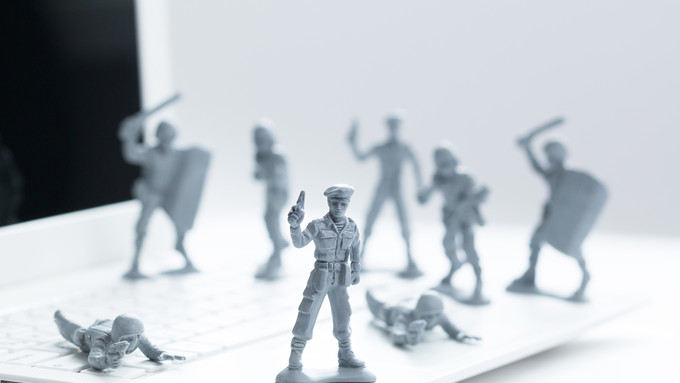Tarantino Al-Baghdadi: ISIS & the Violence of Imagery
This is a translation of an original article posted in Arabic on Al-Araby Al-Jadeed. Photo credit: levonbiss.com
“I came from violence…It was in my blood. My Dad had it. It was all my fate…Innocent? Who's innocent?... It's just murder. All God's creatures do it. You look in the forests and you see species killing other species, our species killing all species including the forests, and we just call it industry, not murder. Everybody got somethin' in their past, some guilt, some sin, some awful secret thing… I think people who deserve to die are those people who are not living in the first place. I think there's a lotta people walkin' round right now who are already dead and need to be put outta their misery… Here starts my mission. I am the messenger of fate.”
Fictional serial killer Mickey Knox said this to a TV interviewer in an interview done from prison. Knox formed a killing duo with his lover, gaining quick fame and becoming popular with the public after filming random violent murders they did, executing people. They became movie-star famous, had a large audience that loved them, rallied for them, and raised their posters. This is despite the fact that those who cheer Mickey on may themselves be killed in a store or another place while the duo is on a killing spree, doing it joyfully in a celebratory way.
This is from the movie “Natural Born Killers”, written by famed director Quentin Tarantino and directed by Oliver Stone. The film introduces the background of this killing duo in an over-the-top theatrical manner as if their lives, rooted in family dysfunction and ugly lifestyles, were not a special case, but more of a general representation of the society, which is introduced through the power of imagery in the same way violence is introduced.
It is an internal case then—violence befalling the society and state, with roots stemming from within, an industry of violence. Mickey Knox did not do anything but practice the logic of this industry, yet in a manner outside the “set frame” for it, or maybe against it. In fact, Mickey exposes this system via imagery. He exposes the deep roots of a society entrenched in its love of violence and its obsession with killers, even if these killers are targeting society itself. This happens as long as people do not seize to glorify practiced violence against them, and in consequence give up certain aspects of their freedom to that violence. This is the “fascist” complex that perplexed Erich Fromm and led him to write his work “Escape from Freedom,” known as Fear of Freedom.
Imagery, or the image, then, becomes the reason for the act of killing, not just an added value, since it becomes the center of modernity and an instrument that represents society, and even forms it. It becomes the age where reality dies for the sake of image, as the French philosopher and sociologist Jean Baudrillard predicted. This is when reality turns into a set of illustrations that echo parallel representations, and reality, therefore, dies under the layers of such illustrations. Politics then turns into a game of representations. This is what happened, according to Baudrillard, in the first Gulf war.
This was also the idea in the movie “Wag the Dog” with Director Barry Levinson where a spin doctor (Robert De Niro) is brought to take the public’s attention away from a sex scandal involving the President. He teams with a Hollywood producer (Dustin Hoffman) to create a fake war in Albania. Heroes, victims, and martyrs emerge as a result. Songs that praise the military and media influence public opinion to stand behind the President. In reality, there was nothing but the created image.
Modernity here means dominion of the image. This idea inspired many movies to criticize an image with another, including David Fincher’s recent film, “Gone Girl”, where a man (Ben Affleck) is accused in the disappearance of his wife. The crime and the real criminal in the movie become very clear to those who are related to the story in reality, but not through its imagery. Instead, the image of the beautiful blonde, portrayed as a victim to man’s violence and lust, is the one that is victorious in the end. So in the refinement of the image and media game alone, imagery prevails, a criminal becomes the victim, and logic, embodied here in the husband’s sister in the film, ends up miserable.
Back to Tarantino and Stone’s movie where in the modernistic system of violence, there’s no moral value to protect an individual’s life, as long as it’s a reason for violence or subject to it, and therefore it loses its human uniqueness. It’s the “Shield of a machine”, as the known architect Le Corbusier put it when he talked about the uses of the modern house and the place of a person in it. It’s the“Eggs that we break” to make an omelette, as Lenin stated, or “Dar al-Kufr” (land of disbelief) where all the lives of those who live in it become a lawful target since they back “the disbelievers and the ignorance of divine guidance” according to the extremists. So as the film “Natural Born Killers” continues with scores of bloody and violent murders done in a joyous and ritualistic manner, the killing duo does not show remorse except for one case when they kill a Native American after he hosted them and prayed for them. To them, it was a heinous immoral act of killing that led to their splitting (temporarily) since that man was not part of the modern violent system.
Also, the person who was filming the duo in Tarantino’s movie plot is part of the group violence celebration that Mickey initiated in prison. The self-serving tabloid journalist is freed and elated by killing, and he discovers joyfully how restricted he was before that, a mere subject to the system. But at the end, this journalist/camera man, who saves the killer from death, becomes a necessary end to the chain of violence, without remorse from his killer, but rather with a feeling of joy as Mickey says to him “convincingly”:
“You’re the last person we’re killing, Wayne… This is not about you, you egomaniac! I kinda like you. But if we let you go, we’d be just like everybody else. Killing you–and what you represent–is a statement. I’m not sure what it’s saying, but Frankenstein killed Dr. Frankenstein.” Wayne responds angrily: “Aren’t you killers?!...The day you killed, you belonged to us! To the public, to the media.”
When a movement of violence—unadulterated violence— in a society is looking for a significance or foundation from a source external to it, it will probably be a fabricated source for it simply does not belong to it. This movement ends up searching for such validation backwardly and retroactively. People addicted to violence will believe that such references are indeed theirs, and that these references represent a motive to practice insurgency and destruction. They believe it in any context where the reference (text) becomes a motive to violence or rebellion. But such texts were not the case in other contexts. In fact, they meant the contrary. This is what over emphasis on the text and tradition misses when backing the violence of the post-modern movements (“jihadist” ones or others), without negating totally that such texts come as motives, and not just for mere justification.
Tarantino, who wrote this movie, repeats this theme in his other movies: the festivity of unstressed violence, comical brutality, and scenes that should be shocking to the soft consciousness (as we imagine in the luxury of modern life) that occur in mostly disinterested comical frames and with characters that represent cultures more than representing personalities. This includes cutting off human limbs and beheadings using swords by a woman in “Kill Bill”, cutting off human ears in “Reservoir Dogs”, dogs eating a live black man and fire burning another in “Django Unchained”, and peeling off a human skull of a live victim in another film. Most of this brutality is practiced as a way to avenge the oppressed against the oppressor. This is one of Tarantino’s delicious hobbies to retell history to make the victim victorious. By the way, this is how ISIS has dealt with its hostages, that they represented their countries, the culture of the "crusading" West, and its policies. ISIS did not punish crimes that the individual hostage committed. And it becomes manifest here that Samuel P. Huntington's concept of the clash of civilizations is prevalent in both cinema and reality.
Jacques Derrida, the French philosopher known for his deconstruction analysis, comments on the terrorist attacks of 9/11: “the most terrifying thing in this form of terrorism against the West is that it is a product of the West itself, and it uses the tools of the West itself. It is the violence of modernity against modernity, not a violence from outside.” And commenting on the same attacks, Jean Baudrillard said: “Al-Qaeda is a violence against the violence of globalization, and we should not understand this violence outside of the generally practiced violence that the West’s policies adopted. This does not make any of the two kinds of violence a moral one,” according to his opinion.
As for ISIS, it did surpass Al-Qaeda in its ability to use the tools of modernity, and in its attention to ‘globalize’ the image. ISIS believes in the centrality of the “image” in today’s world. It practices several forms of violence and savagery against its enemies and against civilians. Such violence has been practiced by armies and militia before, (and we do not have to run a statistical analysis on the crimes of other groups/regimes, nor do we need to declare a condemnation against ISIS violence, which the writer as well as many Syrian people consider them an absolute enemy just like the Assad regime), but ISIS was the most attentive to perfecting the image of violence. They presented skillful ritualistic scenes that expose death and do not conceal it with modern weaponry. This is exactly what made such violence a modernistic one. It is the image that becomes the goal of killing in and of itself—a complex industry that represents reality and forms it at the same time. It becomes a gateway to the world.
So it is not the most heinous act, in terms of morals or human rights, that becomes worthy of the public’s outrage, but it is the act that imagery was able to skillfully prove its heinousness. Therefore, the pictures of Syrians burned to death in Aleppo, Damascus or Homs by the Assad regime, the burned civilians in Rabaa Square at the hands of the Egyptian coup d'etat forces, or the burned ones in Baghdad at the hands of the Shiite Iraqi militia, were not all capable of attracting the globalized outrage as the instance of burning people alive like in the event of the Jordanian pilot, Moaz Al-Kasasbeh. The above mentioned atrocities were not less violent than burning the pilot, but imagery and media concentration were not as present and vibrant there.
It is notable that the ISIS hostages executed before Moaz did not gain the same magnitude of sympathy despite their classification as victims. This is a given as they were in Syria as civilians for the sake of aiding/sympathizing with Syrians in the realm of their revolution, whereas Moaz was a fighting pilot by definition. This goes back to the ISIS slaughter image exhausting all possibilities of astonishment. And this is what ISIS media realized so they chose to be more creative in their violence imagery given the pilot’s exceptional importance as a hostage.
Most of ISIS interpretations of its atrocious and bloody violence seek roots in Islamic tradition for such violence. But ISIS fails to see the modernist system that has a closer root to the imagery that showcases its violence. It seeks to emulate its creativity, using its tools; those on the ground suspect that the directors of these ISIS video releases are Europeans who moved to the “land of Khilafa”. It is likely that such individuals did not read the works of Ibn Taymiyya, Qadi Iyaad, or other books of historical scholars. But they sure did watch many movies, and this time, they feature something that Hollywood greats would not be able to present: the violent imagery is now real.
Activism Related Articles



Why We Must Recapture Scholarly Discourse from Extreme Bloggers
One cannot deny the move towards rhetoric and practice in the Western Muslim community that is more liberal, reformist, and progressive, but the extreme position some have taken in response to it is not only harmful, ineffective, and unwise, but decidedly un-Islamic.